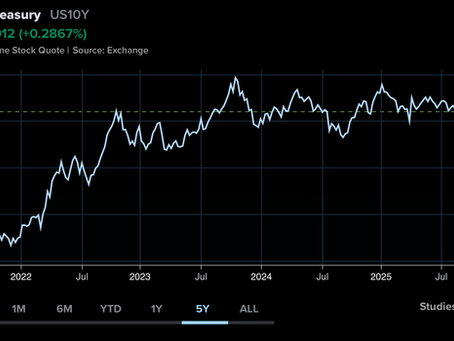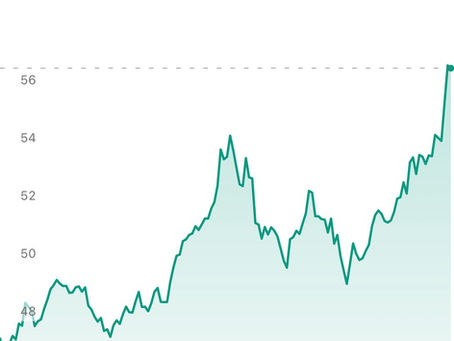top of page

Connect, Aggregate
and Analyze
Fund@mental is the premier professional technology platform within the wealth management community.
Its utilization of advanced research ensures unbiased access to the finest investment products and top-tier analysis.

Easy sharing
Simple by design.
Powerful by necessity.
Access our Insights with
the click of a button


Time to be fearful?
As the year closes, Wall Street starts to come out with predictions on where thr S&P500 will close by the end of next year. You can see the man projections in the chart below. Warren Buffett says that financial projections often tell you more about the person/entity that projects than the projections themselves. All these banks have a vetted interest in the market going up, not necessarily being right. Perhaps it is for that reason that none of them projects a negative result

Gustavo A Cano, CFA, FRM
3 hours ago1 min read


Musical (FOMC) chairs
Now that the Fed week has ended and we’re on the home stretch for the year, investors are starting to think about next year. In terms of monetary policy, it appears to be clear that it will be accommodative. Trump has publicly said he wants rates at 1%, but the market has learned (hopefully) to take his comments with a grain of salt. But the direction is clear. And it’s also clear that the Fed will be less independent from now on. The president wants to be “consulted” on mone

Gustavo A Cano, CFA, FRM
1 day ago2 min read


The infinite (AI) game
The race for Artificial General Intelligence is taking some unexpected turns. The infrastructure needs to be able to train the models and grab market share, implies massive capital expenditures. Whether you call them magnificent 7 or hyperscalers, the big tech megacap companies have committed a big percentage of their revenues to make sure they remain in the race. They all understand the AI race is an infinite game, where there are no explicit rules and no timeframe; the only

Gustavo A Cano, CFA, FRM
2 days ago2 min read


There is no risk-free path
The FOMC concluded its final meeting of 2025 yesterday, announcing a widely expected 25 basis point (0.25%) cut to the federal funds rate, lowering the target range to 3.50%-3.75%. This marks the third consecutive rate reduction this year, bringing the total easing since September 2024 to 175 basis points. The FOMC noted moderate economic expansion but highlighted elevated inflation and rising downside risks to employment. In terms of future rate path: Median expectation poin

Gustavo A Cano, CFA, FRM
3 days ago2 min read


The Fed and the curve
The Fed will conclude today the last FOMC meeting of 2025, and a critical one. With a probability of 85% the market expects a 25 bps rate cut, so it’s now looking for more: what is the dynamic on the committee, how many dissents have been in the discussion, and above all what’s the most likely path for rates in 2026. Bitcoin and precious metals are being bid, and the 2 year treasury is in perfect unison with Fed funds rate. But the real question is what will happen with the l

Gustavo A Cano, CFA, FRM
4 days ago1 min read


The real economy
The real economy is suffering. Despite what we hear from government officials, about low inflation and healthy GDP growth, when you go granular, the story changes. You can see that in the charts below: in the top one, the share of small companies that produce no earnings has reached 40%, and it’s clearly trending up. And if you look at the bottom chart, bankruptcies are now at a 15 year high. We have not reached the levels of the GFC, but it’s clearly trending up as well. Thi

Gustavo A Cano, CFA, FRM
5 days ago1 min read


FOMC week
Everything seems to be ready for the FOMC meeting this week, that will end on Wednesday with a rate cut (currently the odds are 85%) to put the discount rate within the rage of 3.5-3.75%. The 2 year treasury bond, probably the best predictor of Fed funds, is already yielding 3.58%, right in line with the new expected range. As per the rest of major asset classes, if you look at the chart below, absent major changes, they will finish 2025 with strength, but with a different ra

Gustavo A Cano, CFA, FRM
6 days ago1 min read


The UNIT
The BRICS nations (Brazil, Russia, India, China, and South Africa, plus expanded members) have been discussing a gold-backed settlement unit—often referred to as the “Unit”—for several years as a means to facilitate trade among members and reduce reliance on the US dollar. Despite recent headlines, it remains in the pilot and development phase, but it has important implications for the price of gold and bitcoin, as the main goal is to escape from the petrodollar system. How d

Gustavo A Cano, CFA, FRM
Dec 72 min read


Ready for FOMC
The Bureau of Economic Analysis published yesterday the Fed’s favorite inflation indicator, The PCE. Since the FOMC for December meets next week, an is expected to lower rates, the market was somehow anxious to see the data. It grew 0.2% MoM as expected for a YoY growth of 2.8%. Still far from the 2% target, but stable, which can be considered a success in the context of tariffs. As you can see in the chart below, the PCE has been on a range for 2 years, sticky and unable to

Gustavo A Cano, CFA, FRM
Dec 61 min read


Stablecoins
The IMF has published a thorough report on Stablecoins where tries to explain not only how they work, but what are the use cases. This report is timely, because the Trump administration needs another buyer of last resort for the long term treasury bonds they will need to issue to finance the deficit, and rollover the debt that’s maturing, trying to extend durations along the way. As you can see see on the upper chart below, they have a big percentage of their assets invested

Gustavo A Cano, CFA, FRM
Dec 51 min read


Narrative shift
The inflation narrative keeps shifting. After witnessing inflation pressures post COVID monetary and fiscal stimuli, central banks in the world tightened their balance sheets and pushed inflation down to current 2-3% range. Then 2 years ago, central banks stayed to cut rates, with the notable exceptions of Japan, Taiwan and Brazil. And now, the differences between highly indebted nations, the developed world, and the moderately ones, the emerging economies (and where do we pu

Gustavo A Cano, CFA, FRM
Dec 41 min read


Chat GPT impact
It’s the three year anniversary of the launch of ChatGPT, which has come into this world with incredibly high expectations as the technology that will change the fate of humanity. The impact in the markets has been clear: 300% return for the magnificent 7, the handful of companies that are competing among each other, and with China, to reach Artificial General Intelligence (AGI). Even though the US concentrates the bulk of the AI efforts, it’s interesting to see that both the

Gustavo A Cano, CFA, FRM
Dec 31 min read


Yen & Bitcoin
Japan is now the biggest U.S. Treasury holder in the world, with approximately $1.2Tn. It’s the 4th largest economy in the world, and by far, the most indebted. Whatever happens to their economy, affects the world in a meaningful way, and they’re now at a crossroads. Their massive pile of debt is reflecting on its yield the inflationary pressures caused by economic stimuli, and their currency, remains weak, with the potential to weaken even further. The link to the U.S. econ

Gustavo A Cano, CFA, FRM
Dec 21 min read


22 days
And just like that we’re in December, with 22 trading days to end 2025. The last month of the year is typically good for US stocks, with 73% of the months since 1928 being positive, as you can see in the chart below. The S&P500 is up 16.71% since the beginning of the year, and the Nasdaq 21.2%. Bitcoin is down 8.6%, and the dollar index (DXY) is also down 9.3%. Non US markets have so far outperformed the US, in an effort to close the valuation gap. The US bond Aggregate is up

Gustavo A Cano, CFA, FRM
Dec 11 min read


Gold and Silver
Gold and Silver are having an incredible year. In fact, absent a rampant bull market in the last month of the year in Bitcoin, they might take the podium as the most profitable asset class (precious metals) for the year. Silver is up 90%, and gold is up 58% YTD. On Friday, the CME had a problem to open the futures market, that was supposedly related to the inability to deliver phisical silver to one big investor. Officially, it was due to a failure in the cooling system in th

Gustavo A Cano, CFA, FRM
Nov 302 min read


Who is going to tell us?
AI is considered by many as the new economic messiah that will come to rescue the world from years of excessive spending and debt accumulation. It’s supposed to create a new growth paradigm that abound increase productivity in such a way that combined with robots, will make the current era look like Stone Age. But any version of this story, will not happen overnight and it will not happen in a straight line. If you look at the top chart below, you can see where all the CapE

Gustavo A Cano, CFA, FRM
Nov 292 min read


Leverage
Risk taking continues to accumulate on this market. Discussions about the “bubbleness” are not stopping investors from piling up on leverage, wether through traditional margin, or through vehicles that incorporate the loans in its creation, like leveraged ETFs. In the chart below you can see how both are trending up. On the bottom one, traditional leverage has reached $1.2Tn, which dwarfs the prior peaks of 2000 and 2008. On the top, the financial engineering of the leveraged

Gustavo A Cano, CFA, FRM
Nov 281 min read


Deficit breakdown
The U.S. Department of the Treasury released yesterday its Monthly Treasury Statement (MTS) for October 2025, revealing a federal budget deficit of $284.35 billion for the first month of fiscal year 2026. This figure marks a 10.4% increase from the $257.45 billion deficit recorded in October 2024. While the headline number suggests fiscal pressures are intensifying, a deeper analysis reveals a mix of one-off timing effects, policy-driven revenue boosts, and lingering disrupti

Gustavo A Cano, CFA, FRM
Nov 272 min read


The chosen
The Trump administration, through Treasury Secretary Bessent is finalizing the list of candidates for the Fed chair job. From the list, one can only infer that what the president is looking for is someone loyal, that is able to go beyond statistics and models to justify what’s needed. And what’s needed will be determined by the president, for the most part. The independence of the Fed will be deemed secondary, because the U.S. economy is at a point where everybody has to push

Gustavo A Cano, CFA, FRM
Nov 262 min read


Round trip
Just two weeks left of the last FOMC meeting of 2025, and the market has flippped the odds of a cut once again. And the round trip has happened within November. With no data on inflation and unemployment to make informed decisions, investors feared the Fed was not going to venture into additional cuts with the risk of increasing inflation. Then a 150 years study on tariffs effect on inflation by the San Francisco Fed popped up, providing some tehnical background supportive of

Gustavo A Cano, CFA, FRM
Nov 251 min read

©2024 Fund@mental. All rights reserved
bottom of page




